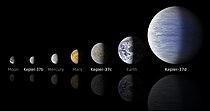Kepler-37b
 NASA Artist Impression of Kepler-37b | |
| Discovery[1] | |
|---|---|
| Discovery date | February 20, 2013[1] |
| Transit | |
| Orbital characteristics | |
| 0.1003 AU[2] | |
| 13.367308 d[1] | |
| Inclination | 88.63°[2] |
| Physical characteristics | |
| 0.303 R⊕[2] 1930 km | |
| Mass | >0.01 M⊕[3] <6 M⊕[4][5][a] |
| Temperature | 700 K[6] |
Kepler-37b is an extrasolar planet (exoplanet) orbiting Kepler-37 in the constellation Lyra.[7] As of February 2013[update] it is the smallest planet discovered around a main-sequence star, with a radius slightly greater than that of the Moon.[8] The measurements do not constrain its mass, but masses above a few times that of the Moon give unphysically high densities.[5]
Discovery

Kepler-37b, along with two other planets, Kepler-37c and Kepler-37d, were discovered by the Kepler space telescope, which observes stellar transits.[1][6] After observing transits of Kepler-37b, astronomers had to compare it with the size of the parent star.
The size of the star was obtained using asteroseismology;[clarification needed][9] Kepler-37 is currently the smallest star to be studied using this process.[6] This allowed the size of Kepler-37b to be determined "with extreme accuracy".[6]
To date, Kepler-37b is the smallest planet discovered around a main-sequence star[b] outside the Solar System.[8] Detection of Kepler-37b was possible due to its short orbital period, relative brightness, and low activity of its host star, allowing brightness data to average out quickly.[10] The discovery of Kepler-37b has led Jack Lissauer, a scientist at NASA's Ames Research Center, to conjecture that "such little planets are common".[6]
Orbit
Kepler-37b orbits its parent star at a distance of about 15 million kilometers (9.3 million miles), with a period of roughly 13 days.[8] The outer two planets in the system have orbital periods[1][2] within one percent of the 8:5 and 3:1 resonances with Kepler-37b's period.
Physical properties
Kepler-37b is located approximately 210 light-years from Earth.[11] It is slightly larger than the Moon, with a diameter of about 3,900 kilometres (2,400 mi).[9] NASA states that it probably has no atmosphere and cannot support life.[6] Furthermore, it is most likely composed of rocky materials.[6] Because it is so close to its star (Mercury is more than three times as far from the Sun), Kepler-37b's mean temperature is estimated to be around 425 °C (800 °F).[6]
See also
Notes
- ^ Masses more than a few times that of the Moon result in unphysically high densities.
- ^ The pulsar planet PSR B1257+12 A has a comparable mass. The actual size of PSR B1257+12 A is unknown, but is likely comparable to Kepler-37b.
References
- ^ a b c d e Barclay, T.; Rowe, J. F.; Lissauer, J. J.; Huber, D.; Fressin, F.; Howell, S. B.; Bryson, S. T.; Chaplin, W. J.; Désert, J. M. (2013-02-20). "A sub-Mercury-sized exoplanet". Nature. 494 (7438): 452–4. arXiv:1305.5587. Bibcode:2013Natur.494..452B. doi:10.1038/nature11914. ISSN 0028-0836. PMID 23426260. Retrieved 2013-02-21.
- ^ a b c d "Kepler-37 System". kepler.nasa.gov. Retrieved February 21, 2013.
- ^ http://kepler.nasa.gov/news/index.cfm?FuseAction=ShowNews&NewsID=256
- ^ http://exoplanet.eu/catalog/kepler-37b/
- ^ a b [1]
- ^ a b c d e f g h "NASA's Kepler Mission Discovers Tiny Planet System". NASA. February 20, 2013. Retrieved February 21, 2013.
- ^ Smallest Alien Planet Kepler-37b Explained (Infographic)
- ^ a b c "Tiniest Planet Yet Discovered by NASA Outside our Solar System". scienceworldreport.com. February 21, 2013. Retrieved February 21, 2013.
- ^ a b "Astronomers Find the Tiniest Exoplanet Yet". Slate. February 20, 2013. Retrieved February 21, 2013.
- ^ Centauri Dreams - Small Planets Confirm Kepler’s Capabilities
- ^ "NASA, using Kepler space telescope, finds smallest planet yet". Los Angeles Times. February 20, 2013. Retrieved February 21, 2013.




